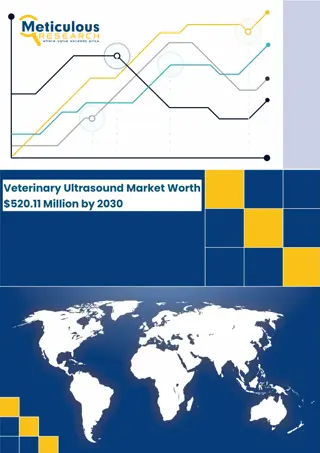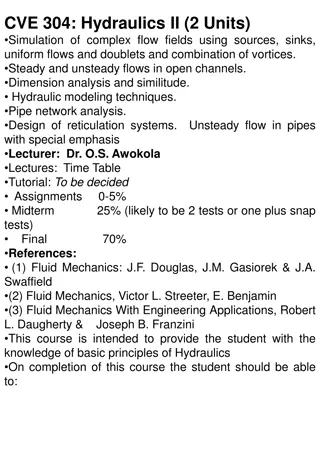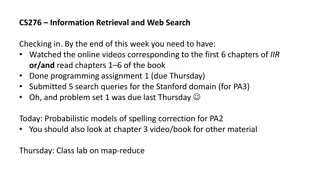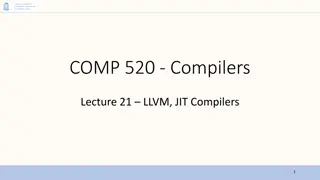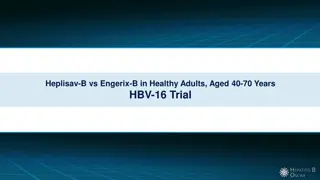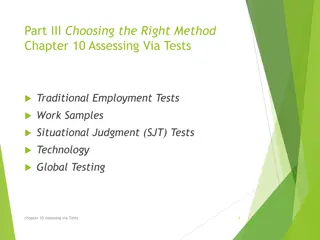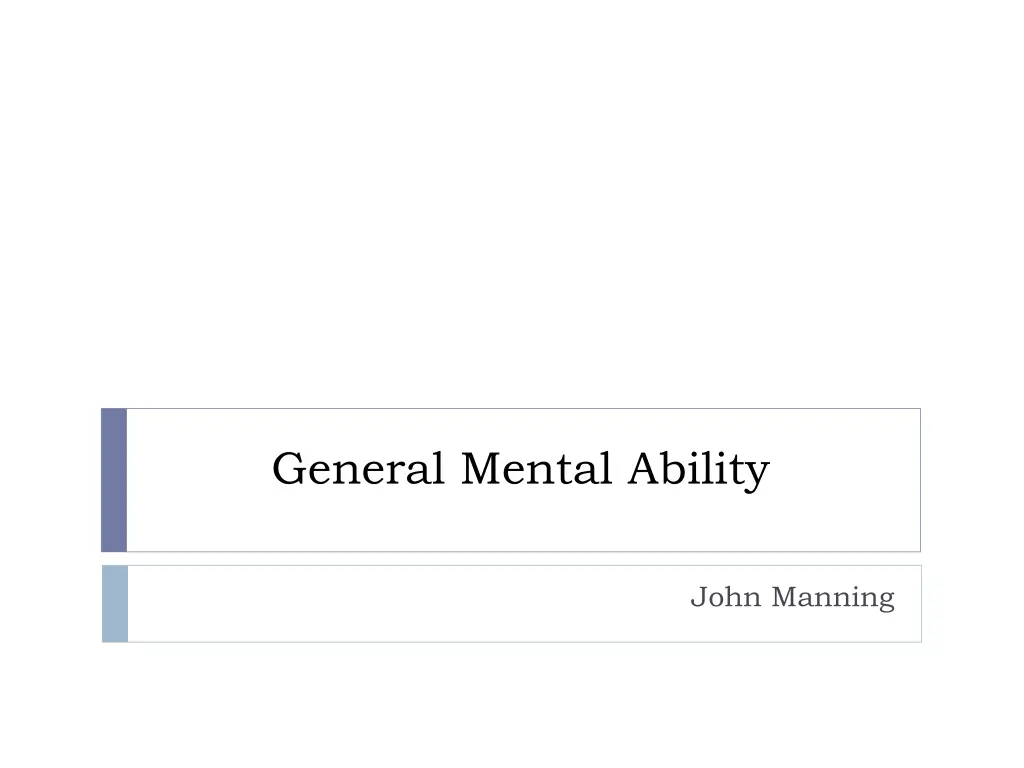
Understanding General Mental Ability & Its Impact on Performance
Explore the history, definition, and applications of General Mental Ability (GMA), its correlation with job performance, individual differences, and stability over time. Discover the genetic inheritance of GMA, correlates with childhood outcomes, and the stability of this cognitive trait.
Download Presentation

Please find below an Image/Link to download the presentation.
The content on the website is provided AS IS for your information and personal use only. It may not be sold, licensed, or shared on other websites without obtaining consent from the author. If you encounter any issues during the download, it is possible that the publisher has removed the file from their server.
You are allowed to download the files provided on this website for personal or commercial use, subject to the condition that they are used lawfully. All files are the property of their respective owners.
The content on the website is provided AS IS for your information and personal use only. It may not be sold, licensed, or shared on other websites without obtaining consent from the author.
E N D
Presentation Transcript
General Mental Ability John Manning
Overview History of General Mental Ability Definition, Models Measures of GMA Applications GMA and Job Performance Individual Differences Race, Gender, Age Alternatives?
What is GMA? It goes by many names: g, general mental ability, IQ, intelligence A general measure of cognitive functioning that should work across several different domains First proposed by Francis Galton (1888), an English geneticist and relative of Darwin Spearman (1904) proposed g - a general underlying intelligence factor that accounted for correlations between different areas on measures of intelligence. It remains one of the most studied of all human characteristics
Just how positively correlated are these subdimensions? 1 2 3 4 5 6 7 8 9 10 Science Arithmetic Word knldg Paragraph Numeric Coding Auto+shop Math knldg Mech comp Electronic 1.00 0.73 0.82 0.72 0.57 0.51 0.68 0.70 0.71 0.77 1.00 0.72 0.70 0.63 0.55 0.59 0.82 0.70 0.68 1.00 0.82 0.65 0.60 0.61 0.69 0.64 0.72 1.00 0.64 0.61 0.51 0.67 0.57 0.63 1.00 0.72 0.38 0.62 0.45 0.47 1.00 0.33 0.54 0.41 0.42 1.00 0.47 0.75 0.76 1.00 0.62 0.60 1.00 0.75 1.00 Source: National Longitudinal Study of Youth ASVAB Scores, sample size is 11878 test takers Factor 1 2 3 4 Correlation between the supposedly distinct ACT and SAT? R=0.91; R2=0.82 Eigenvalue Difference Proportion Cumulative 6.40 5.64 0.76 0.54 0.22 0.08 0.14 0.16 0.91 0.11 0.03 0.02 0.91 1.02 1.05 1.07
General mental ability and stability The genetic inheritance of GMA Two statistics: h2 (genetic effect) c2 (shared effect) The effects of heredity only get stronger with age
Correlates of GMA Childhood outcomes Average r=0.50 with school performance However, children in Japan and China know more math than American children even though IQ scores are very similar Average r=-0.19 with juvenile crime General psychomotor skills Reaction speed r=.30 Judgment speed r=.55
GMA and Stability Is it really a trait? Is it stable? Test re-test Age 6 to 18=0.77 Age 12 to age 18=0.89 Even higher correlations if tests are given on multiple occasions What does this mean? It means that rank order is very stable over time It does not mean that an average (100 IQ) 6 year old can do what an average 18 year old can do
Correlation of GMA (1980) with life outcomes (1990) Sample size = 8891 (NLSY) 0.70 0.60 0.50 0.40 Correlation 0.30 0.20 0.10 0.00 -0.10 -0.20 Education Income Self-esteem Weeks unemployed -0.30 Criteria Data clearly show that general mental ability as measured by the ASVAB is correlated with education levels, income, self-esteem, and weeks of unemployment even with a 10-year gap between measures
Measures of GMA General Aptitude Test Battery (GATB) Wonderlic Personnel Test Armed Services Vocational Aptitude Battery (ASVAB) IQ Tests (WAIS-IV, Stanford Binet, etc.)
Examples of items from the Wonderlic Personnel Test
Overall it seems like GMA is a perfect selection tool It s very stable over time It s related to measures of learning ability and adaptability It s one of the best predictors of job performance available The tests are cheap (about $2.00 per applicant tested) It really doesn t matter which test you use since they all measure the same thing But
there are potential problems with GMA test scores The subtests show differences for gender Women score higher on verbal intelligence Men score higher on visual-spatial intelligence and the math section of the SAT These differences are not very great and there are massive overlaps However, overall IQ scores are basically equivalent for men and women
GMA Scores and Race/Ethnicity There are clear differences in GMA scores based on ethnicity African-Americans scored about 1 SD below Whites, although more recent data suggests this difference is closer to 0.6 to 0.7 SD Latinos score between Whites and African- Americans Asians score slightly higher than Whites Ashkenazi Jews score about SD higher than other White groups
Returning to our conception of biased from earlier GMA tests predict just as well for both groups, but one group gets lower scores This passes the equity standard, but not equality There is no factual or logically rigorous reason to say this is okay or not
GMA for selection % of U.S. Workers in these occupations GATB Validity for: Proficiency ratings Training success Job complexity General job families High (synthesizing/coordination) Medium (compiling/computing) Low (comparing/copying) Industrial job families High (setup work) Low (feedback/offbearing) 0.59 0.51 0.40 0.50 0.57 0.54 15% 63% 18% 0.56 0.23 0.65 n/a 3% 2% Percentage of training success explained by: Everything else 0.8% 1.8% 2.6% 7.0% 0.6% 1.0% 1.4% 7.7% 2.7% GMA 77.3% 69.7% 68.7% 66.7% 59.7% 55.2% 53.6% 49.3% 28.4% Nuclear weapons specialist Air crew operations specialist Weather specialist Intelligence specialist Fireman Dental assistant Security police Vehicle maintenance General maintenance
The Relation Between General Mental Ability (GMA) and Performance in Job Training and on the Job: Representative Findings From Meta- Analyses Study Occupation Hunter and Hunter (1984) Medium complexity .51 Pearlman et al. (1980) Clerical Hirsh et al. (1986) Law enforcement McHenry et al. (1990) Military enlisted McHenry et al. (1990) Military enlisted Hunter (1986) Military enlisted Ree et al. (1994) Military enlisted Ree and Earles (1991) Military enlisted Schmidt et al. (1979) First-line supervisors .64 Schmidt et al. (1979) Administrative clerks .67 Schmidt et al. (1980) Computer programmers .73 Callender and Osburn (1981) Refinery workers Performance measures On the job .52 .38 .63b .65c NR .45 NR In training .57 .71 .76 NR NR .63 NR .60 NR NR NR .50 .31
Applicant reactions to GMA tests In general, results suggest applicants tend to find GMA tests acceptable They especially like tests that are called personnel tests They like tests more when they are paired with individual interview information They usually like tests of knowledge and abilities more than they like personality tests or biodata.
Bobko, Roth, & Potosky: Cognitive Ability and Alternative Predictors Their meta-analytic matrix shows that structured interviews, conscientiousness, and biodata all have much lower d-scores than cognitive ability in terms of prediction, and many of these alternatives have good correlations with job performance
Validity vs. Value GMA is the single strongest predictor of performance Value of interviews, collecting biometric data, etc.?
To wrap it up GMA is the totality of mental processes involved in adapting to the environment. Underlying component of all different aspects of intelligence. Stable over time, strong genetic/heredity component Strong predictor of future job performance, especially with complex and technical jobs. People like GMA tests. Value of alternatives?



